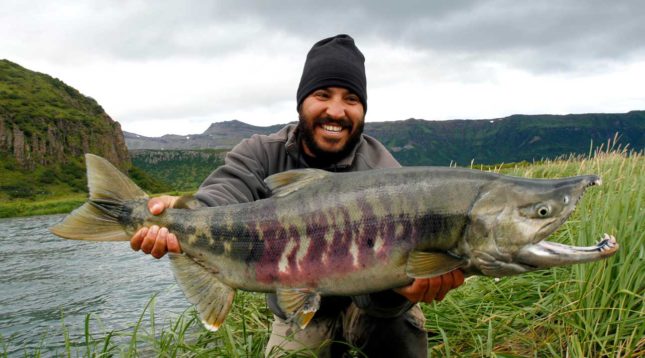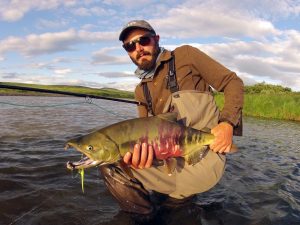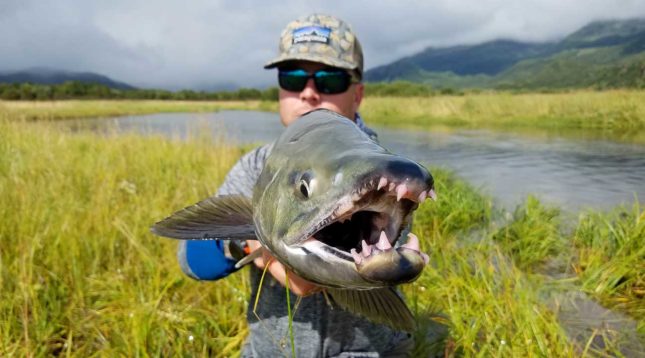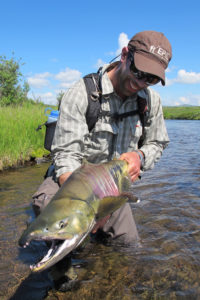Epic Blog
Seven Species Series: Chum Salmon
07.13.20
Part One: Chum Salmon
Alaska is known for being the land of Salmon, and for good reason. The runs still number in the millions for some drainages, and nowhere are they more prolific than in the unspoiled rivers of Bristol Bay. For anyone who has visited this vast wilderness region of southwestern Alaska and has witnessed the salmon return with their own eyes it is something they will likely never forget.
Imagine being able to peer through a portal to glimpse a vision from the past. These last great runs are a reminder of the once incredible abundance of natures bounty that existed in every watershed that reached the Pacific Ocean, from central California to the coasts of Hokkaido, Japan.
While the different species of Pacific Salmon are the main economic drivers behind both the commercial fishing industry and the recreational one, they alone only tell half the story of the incredibly rich waters of southwestern Alaska. In this multi part series we will profile the various species targeted at our two remote wilderness fly fishing camps on the Alaska Peninsula. Let us start with our first camp, OUTPOST.
In the beginning
During the early months of summer the sun never truly sets on our small tent camp. What you have in place of nights darkness is a perpetual twilight as the sun traces a shallow line just below the horizon. The long winter of the North is over, and with it comes the promise of summer’s annual bonanza. Out in the Northern Pacific ocean, and the storm lashed seas of the Bering, untold hundreds of millions of fish have begun to steer themselves towards land, remembering the bargain they made with the rivers and streams of their birth. They will return to spawn and then to die.
We have come in anticipation of their arrival. All of us fishermen, of one stripe or the other.
In the beginning the home waters of our camp do not teem with salmon. They are coming, but for now the deep bends and long glides of our creek belong to the full time residents; the rainbow trout and arctic grayling. Soon, however, all of this is going to change.
Every dog has his day
Mid June, 2017. I was a first year guide with EPIC and pretty green at that. I had fished plenty, guided some, but now that I found myself thrown into the mix of being a remote Alaska wilderness guide with two complete strangers as my campmates I felt a little out of sorts. The first time I met Rus was when I stepped off a helicopter and onto a gravel bar in the middle of nowhere. Too late to reconsider now. Maybe this wasn’t such a good idea after all? We worked hard that first day, I remember that. Everything was intimidating, I remember that as well. Maybe I’d feel better once we got to do some fishing.
It’s hard to say how many days went by of working in camp before we took that first boat ride down river to where the mouth of our creek dumps into the glacial King Salmon. It was overcast and grey. A misting rain fell as Rus piloted the boat through the mixer of the two drainages. There, at the confluence, I remember seeing what looked like a hundred shadows spook away and disappear under the silty cloud of brown water as I peered over the gunnels with all of the wide eyed wonder of a child.
Rus, standing in the stern of the boat with his hand on the tiller said something through the drone of the engine and the hum of the river.
“Chums!”
We parked the boat on an island of grass tall up to your chest. The water of the creek was the color of tea. The bank on the far side cut steep and rocky. This was my first time fishing for salmon in Alaska. I’m sure my fingers trembled some with excitement as I threaded my fly line through each guide to the tip of my rod. I wish I could remember what fly I tied on first, but it’s safe to say that it was most likely a streamer. I stepped out and started to cast, hoping I wouldn’t do something stupid like throw a collision loop right off the bat or snag the bank with my backcast.
They told me to wade down further, towards the end of the creek, closer to where it meets the big river. I obeyed and proceeded to cast. Then I got a grab that was so hard and violent I thought the rod was going to leap out of my hands and be flung across the creek mouth to the opposite bank. I missed it, damn! I cast again. Another gnarly grab. Another miss.
Some interjection from the spectators watching from the bleachers:
“Set harder! You gotta set harder!”
I made another cast, this time knowing when to anticipate the fly line going tight. And it did. Few things are as exciting as getting to live in the moment of a fish eating your fly. To watch the inert line come alive with the pull of a big fish on the other end; it feels like a current of electricity is running through the line, down the length of the rod and into your heart.
She fought well, giving stubborn head shakes and using the heavy current to her advantage. It was a good match for my old Sage Access 8 wt. I remember taking a knee once she had come to hand because I wanted to have a good look at her. A smaller hen, maybe 6 – 8 pounds but still in decent shape for being so far along on her journey. I had found her some sixty plus miles upriver from where she had left her saltwater home. How much further up stream she had to go before spawning is impossible to say, but she had made it most of the way.
What’s in a name?
Chum Salmon, or Dog Salmon as they are alternatively called, are a member of the Oncorhynchus (hooked nosed) family of Pacific Salmon. They’re a kind of black sheep, not having the tell tale spotted backs that are synonymous to most of their salmon and trout cousins. Out at sea their bodies are metallic and chrome, making them hard to tell apart from silvers, or sockeye, but once they begin to show their spawning colors it’s a different story. The further they travel upriver, the darker they become. Once we find them at our first camp most of them are displaying some variant of this coloration, a combination of greenish yellow through the body with tiger striped marks of red and purple running down their sides with some black towards their tail fin.
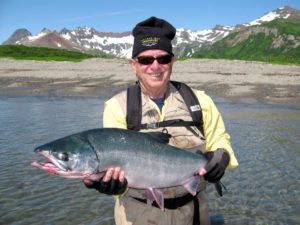
To the untrained eye, chum salmon in their ocean-fresh phase are difficult to distinguish from silver and sockeye salmon.
In Alaskan waters it’s one of the first salmon to show up, typically entering their natal watersheds in early June through August. Most folks assume their two common names are pejorative, but that’s a misleading assumption. They earned the name Dog for the impressive canines the spawning males display as they vie for the rites to court and mate with a hen. Chum comes from the phonetic form the Chinook peoples used to describe the fish, Tzum, which means “spotted” or “marked.” Perhaps most astonishing is the fact that the chum has one of longest migration routes of all their Pacific Salmon relatives. Traveling distances in excess of 2,000 miles in rivers like the Yukon and Amur. That would be the equivalent of swimming upriver from my home on the Northern California coast to Texas.
A worthy opponent
For most of our first time clients who visit us in the early part of our season at OUTPOST camp, their first experience fly fishing for salmon will be for chums. They will all exalt at the power and tenacity of playing such a hard fighting fish on fly tackle. They are truly bare-knuckle brawlers when hooked, testing the limits of any rod in the 6 – 8wt range. I’ve seen more rods snap when the unwitting angler underestimated just how powerful these fish are, the second largest of all Pacific Salmon. Perhaps inevitably, as our guests and guides alike begin to settle in and experience the full range of different species that are on the menu for our two camps, the chum falls from grace, ending up towards the bottom rung of the hierarchical fish ladder. I have heard it said over and over again,
“Just another chum”
What was once venerable becomes neglected. The initial thrills fade and are forgotten in place of new thrills and rewards. That is human nature, but I would caution against forming such biases, as both an angler and a guide. I only have to remind myself of that first fish to remember where the chum rightfully belongs; to see that same excitement and exuberance written on the face of every newcomer as they are guided into their first chum, watching with silent satisfaction as their fly gets demolished as mine did, I am allowed to relive that moment again. And for that, I am grateful to the chum.
Stay tuned for the next chapter of this multi-part fish species series. Until then.
Written by Drew Griffith (aka “Machete”). June, 2020
Find more Machete articles here.
Posted in All Posts, Fishing, OUTPOST

